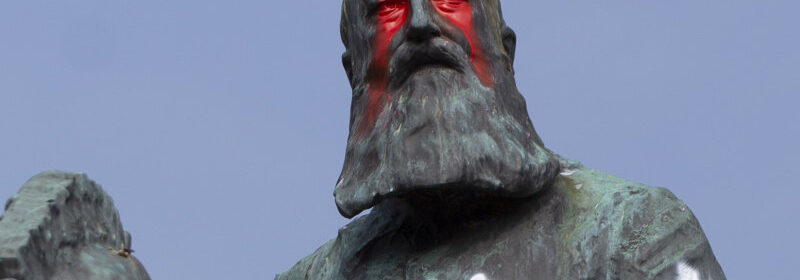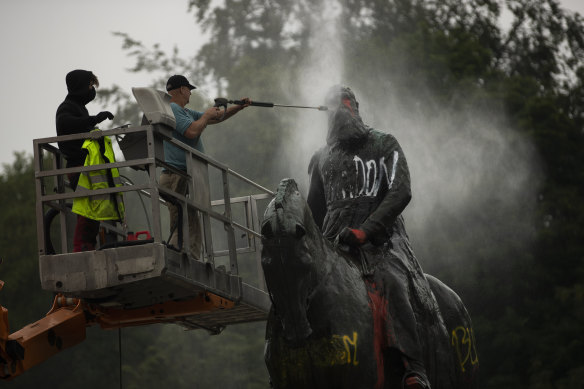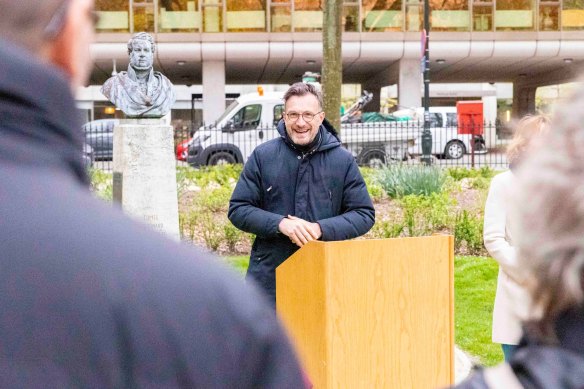European capital confronts the ghost of its brutal Builder King

Save articles for later
Add articles to your saved list and come back to them any time.
Brussels: The ghost of Leopold II still looms large over the Belgian capital, a city which has long provided the political heartbeat of Europe.
In every corner of the place, the parks, avenues and buildings bear either Leopold’s name or honour the generals he sent to far off lands as part of his ambitious plans for his kingdom and its modest capital. He wanted to make Belgium a world power, and Brussels more beautiful than Paris.
Workers clean graffiti from a statue of Belgium’s King Leopold II in Brussels that was targeted by protesters during a Black Lives Matter demonstration in 2020. Credit: AP
Known as the Builder King, a man whose majestic statue on horseback still looms large outside the royal palace, Leopold II took control of the Congo during the 19th-century scramble for Africa. His ruthless and bloody plundering in the region has ever since left a stain on Belgium’s reputation.
Until a sharper focus over the past two decades, many Belgians had remained ignorant of their country’s harsh colonial rule over several African nations, including Rwanda and Burundi. Slave labour was used to harvest products including rubber. The proceeds laid the foundation for the modern-era prosperity of Belgium, a country of 11.5 million people and home to European Union institutions.
But now Brussels, having endured mass protests as part of the Black Lives Matter movement three years ago, is intent on correcting and contextualising its history as the government embarks on a world-first program to decolonise its public spaces.
“Most ordinary people just don’t know, or sometimes care, but it is part of our history and for Brussels, as a multicultural city, everybody has to recognise it,” says the city’s planning and heritage minister, Pascal Smet, who launched a 14-point plan this month to make the city more inclusive and aware of its past.
Pascal Smet, Brussels’ minister for planning and heritage, is addressing symbols in public spaces related to the colonial period.
“The whole idea of this is let’s recognise the past, let’s embrace it and don’t fall into the trap of individually blaming citizens. It’s a collective responsibility of the past. And so, we have collectively to recognise it as a society.”
Belgium only began to seriously confront Leopold’s regime after the publication in 1998 of Adam Hochschild’s King Leopold’s Ghost, which detailed the systematic cruelty of his rule. Hochschild shocked the world with the horrific figure of 10 million Congolese dead in a “forgotten holocaust” – a figure some historians continue to dispute.
Early reports of the horrors prompted the emergence in the 1900s of the world’s first international human rights campaign. Among those to join the campaign was Mark Twain, who wrote a stinging pamphlet attacking Leopold in 1905. Belgium’s rapacious activities in the Congo Free State also led Joseph Conrad to set Heart of Darkness there. (The novel was, in turn, the inspiration for Francis Ford Coppola’s 1979 Vietnam War film Apocalypse Now.)
In April 2019, the Belgium government apologised for the kidnapping, segregation, deportation and forced adoption of thousands of children born to biracial couples during its colonial rule. Last year King Philippe of Belgium expressed his “deepest regrets” for acts of violence and brutality inflicted during his country’s rule over the Congo, but the royals remain split and have ruled out reparations.
The king’s younger brother, Prince Laurent, has refused to concede that any blame should be attached, stating afterwards: “He never went to Congo himself … I do not see how he could have made people there suffer.”
A working group that began efforts in 2020 to deal with the problem was spearheaded by Smet and included 20 experts. Additionally, it has proposed universal guidelines that can be adopted by other cities, amid the fallout in the US over statues of Confederate generals and in the UK over statues of slave traders. Those who seek the statues’ removal have often been accused of erasing history.
The group said Belgium’s past colonial actions, including the violent treatment of native people, theft of natural resources and racism were “established historical facts that are not always recognised and fully acknowledged”.
Included in the final report on the issue were plans for King Leopold in the Place du Trone, which was targeted by anti-racist protesters after the killing of George Floyd in the US and daubed in red paint.
The group suggested several options, including concealing the statue with a structure that provides information on Belgium’s colonial history, and removing the figure entirely and storing it in a depot full of similar symbols. A more radical solution suggested it could be melted down and re-forged as a memorial to victims of colonialism.
Another artwork, a bust of Lieutenant-General Emile Storms, was quietly removed from a park last year in the city’s Square de Meeus under the pretext of restoring the public gardens. It will return to public display but not in its original place or state. Storms, a soldier, explorer and official for the Congo Free State, is notorious for the killing of Lusinga Iwa Ng’ombe, a Congolese chief who was robbed, murdered and beheaded by the colonial general in 1884. His skull was taken as a personal trophy.
Belgium has an estimated 4500 statues, street names or other public reminders of the colonial era. Removing them all would be an enormous task, but Smet says it would also risk wiping out the past when the country should instead be engaging with it.
“If you throw them away then you throw history away. It is important, at least for me, that you contextualise history,” he says.
Smet’s plan does not recommend tearing down all statutes, but proposes a case-by-case approach on what to do with them. Some monuments could be removed to museums or a statue park, similar to existing “graveyards” of Soviet monuments in the Hungarian capital, Budapest, and in Tallinn in Estonia. Other monuments could be renamed or put in context with information plaques.
Georgine Dibua Mbombo, a member of the 14-strong group of historians, architects and other specialists that produced the report, says while apartheid was not declared in Belgium, it was institutionalised in public spaces “and in the minds”.
Dibua Mbombo, who runs Bakushinta, a group dedicated to promoting Congolese culture in Belgium, has raised issues about Cinquantenaire Park, created in 1880 to mark 50 years of the Belgian state. The park remains strongly linked to the exploitation of the Congo.
She told local reporters that agreeing on how to contextualise works that glorify a colonial past was not simple, and that putting up information panels or QR codes was not a solution because she was unconvinced that people read them.
“Not all colonial symbols are problematic in the same way, nor for the same reasons,” she said.
“Sometimes the problem lies in the person or event commemorated (e.g. the bust of Lieutenant-General Emile Storms), other times in the racist images or in the wording, inscriptions and associations evoked.”
Get a note directly from our foreign correspondents on what’s making headlines around the world. Sign up for the weekly What in the World newsletter here.
Most Viewed in World
From our partners
Source: Read Full Article


